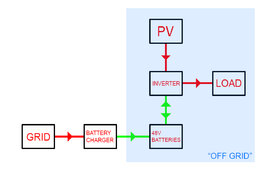robinlawrie
New Member
Ok so im still trying to plan a solar setup that will do what i want within my budget. The house has a 3 phase grid supply currently on a contract limited to 6kw. 3 phase becuase it was previously a small countryside school..
Given the current very low price of solar panels, my large flat roof, and abundant electricity consumption, im aiming for a 10-15 kw array.
Paired with a suitable inverter ( this, seems suitable: https://voltaconsolar.com/products/hybrid-solar-inverter-15kw-three-phase-48v)
and a 20 -30 kwh battery setup (a couple of seplos Mason with EVE cells seem an excellent value choice) .
This is all fine, until you come to the laws (these may be the same everywhere, but given italy is famous for having millions of rules, maybe not)
Over 6kw, a certified engineer must design the system ($$$)
Over 6kw, a govt. inspection is required every few years ($$)
any system connected to the grid must be installed by a certified contractor ($$$)
Any inverters connected to the grid must be CEI certified and MUST NOT provide power to the house in the case of a blackout, to avoid risk of back-feeding to the grid.
Software settings on hybrid inverters are not considered sufficient, and these devices are illegal to install unless off-grid.
Now i can understand the thinking behind all of these rules..
however they get in the way of me making a nice semi off-grid system within my budget, taking from the grid only when solar/batteries are insufficient.
Considering economic solutions, I thought that it might be possible (maybe it has a name already?) to create an off-grid system which powers the entire house. , but connect the grid to a nice big three phase 48v battery charger (forklift charger? or something designed specifically) . The output of which charges the same batteries the off-grid inverter does.
Some kind of control logic tells the charger to switch on when the battery soc drops below a certain threshold and/or when the inverter isnt charging the batteries. (maybe the inverter has the abilty to control this)
That way i have no direct connection to the grid, no risk of back-feeding, and avoid all the paperwork and fees.
The only downsides i can see are:
1. wasting excess power however the tariffs here pay you practically nothing so, not so bothered, im sure i can find something to do with the juice.. ( heated pool, diy thermal store? lots of ideas)
2. round trip efficiency, always going via the batteries.. ill probably waste quite a few percent..
3 added cost of charger.. this is much less than the cost of the paperwork and a professional installation would be.
Anyone care to offer thoughts on this idea? disadvantages? links? i assume some variation on the theme has been done many times before but i dont know how to search for it. ?
thanks, Robin.
Given the current very low price of solar panels, my large flat roof, and abundant electricity consumption, im aiming for a 10-15 kw array.
Paired with a suitable inverter ( this, seems suitable: https://voltaconsolar.com/products/hybrid-solar-inverter-15kw-three-phase-48v)
and a 20 -30 kwh battery setup (a couple of seplos Mason with EVE cells seem an excellent value choice) .
This is all fine, until you come to the laws (these may be the same everywhere, but given italy is famous for having millions of rules, maybe not)
Over 6kw, a certified engineer must design the system ($$$)
Over 6kw, a govt. inspection is required every few years ($$)
any system connected to the grid must be installed by a certified contractor ($$$)
Any inverters connected to the grid must be CEI certified and MUST NOT provide power to the house in the case of a blackout, to avoid risk of back-feeding to the grid.
Software settings on hybrid inverters are not considered sufficient, and these devices are illegal to install unless off-grid.
Now i can understand the thinking behind all of these rules..
however they get in the way of me making a nice semi off-grid system within my budget, taking from the grid only when solar/batteries are insufficient.
Considering economic solutions, I thought that it might be possible (maybe it has a name already?) to create an off-grid system which powers the entire house. , but connect the grid to a nice big three phase 48v battery charger (forklift charger? or something designed specifically) . The output of which charges the same batteries the off-grid inverter does.
Some kind of control logic tells the charger to switch on when the battery soc drops below a certain threshold and/or when the inverter isnt charging the batteries. (maybe the inverter has the abilty to control this)
That way i have no direct connection to the grid, no risk of back-feeding, and avoid all the paperwork and fees.
The only downsides i can see are:
1. wasting excess power however the tariffs here pay you practically nothing so, not so bothered, im sure i can find something to do with the juice.. ( heated pool, diy thermal store? lots of ideas)
2. round trip efficiency, always going via the batteries.. ill probably waste quite a few percent..
3 added cost of charger.. this is much less than the cost of the paperwork and a professional installation would be.
Anyone care to offer thoughts on this idea? disadvantages? links? i assume some variation on the theme has been done many times before but i dont know how to search for it. ?
thanks, Robin.





